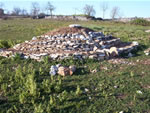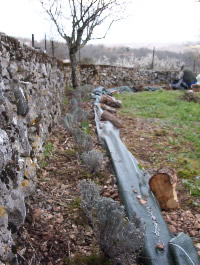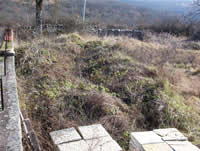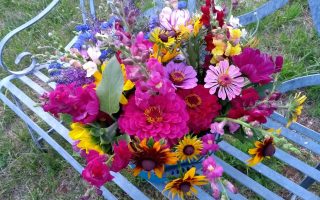The Celtic Herbalist – March Update

Work in Progress
The Celtic Herbalist’s gardens are developing on the four and a half acres around a farmstead upon one of the limestone plateaux (or causses) in the Midi, near Toulouse, in S.W. France.
For an introduction to the gardens see:
The Celtic Herbalist’s Gardens.
Works In progress
Preparatory Work
The walls of the cistern were built with 9″ hollow blocks and the voids then filled with hand-poured concrete – there must be an easier method. Once the walls were firm, a butyl liner was placed within and beam-and-block covering set to span over the cistern.
Below you can see that all that is left to do is to fill the gap between the cistern and the house with hardcore and float a concrete terrace over it.
Garden number 1: The Gaul’s Potager
 This is a garden of vegetables, fruit, flowers and herbs arranged in a geometric pattern: three large vegetable beds with four rough circles around them. These comprise: a pool, a fruit mound, a salads’ wheel and a grain circle.
This is a garden of vegetables, fruit, flowers and herbs arranged in a geometric pattern: three large vegetable beds with four rough circles around them. These comprise: a pool, a fruit mound, a salads’ wheel and a grain circle.
In the centre is a fire pit with a quatrefoil of culinary herbs around it. The pit represents the fire often found in the middle of a Celtic village.
The fruit mound will be jealously guarded by the Spirit of the Fruit (a Celtic style manikin) on its summit.
Garden number 2: Rhiwallon’s Garden
 This is a memorial garden of tincture beds. It is in memory of Rhiwallon of Myddfai the physician who, in the 13th century, collected the remaining two-thousand year old Celtic remedies in the oral tradition still extant, at that time, in Britain.
This is a memorial garden of tincture beds. It is in memory of Rhiwallon of Myddfai the physician who, in the 13th century, collected the remaining two-thousand year old Celtic remedies in the oral tradition still extant, at that time, in Britain.
The garden comprises nine rectangular beds of medicinal herbs arranged in the medieval fashion with the requisite water feature (here, with pestle and mortar) overflowing into the stone basin.
A Celtic cross, recording Rhiwallon’s life is under the peach tree and a Celtic style bench is being made for under the fig tree.
Garden number 3: Llyn-y-Van-Vach
 This garden is a “Celtic Reflection Garden”.
This garden is a “Celtic Reflection Garden”.
This is to be a formal rectangular pool with a large Cauldron of Keridwen emptying into the pool for oxygenation. This will be backed by two large fastigiate yews and surrounded by old, hand-cut stones.
[mrb]
What is “Celtic” Gardening?
The word Celtic used with gardens obviously does not mean the style of gardens that the Celts had. Theirs were obviously limited to some grains and greens. Our use of the word refers, largely, to plant choice, aesthetic style and spiritual inspiration.
These gardens are being designed and installed by an experienced, RHS qualified Garden Designer, Mr. M. Judd. Mike Judd has designed and installed gardens around the world, from South Africa to the South of France.
The core of Celtic belief, after worship of the sun, was the ‘Cult of Wood and Water’. Water sources were “sacred” to the Celts, just as they are becoming to us, yet again. Hence, Celtic gardens concern themselves with the restoration, conservation and construction of ponds and wetland. These are valuable habitat. If we cannot recreate the other sacred Celtic landscape feature: woodlands, we can at least, make a small pond for fish, fowl, amphibians and insects.
This emphasis on the importance of life in the Celtic Garden extends to plant life, naturally. Where edible cultivars, or certain species are not vital for foodstuffs, and medicines, we use plants, shrubs and trees indigenous to the old Celtic lands. Basically this means France (Gaul), Britain, Spain and Germany, with an emphasis on species that prefer Warm Temperate (or even Arid) climates. Part of the conservation process on our site will include the (legally sanctioned) introduction of endangered French species. Many of these are herbaceous and floriferous and will be emplaced in the small quantity of sward that we allow ourselves in a garden which is largely woodland and wetland. Celtic Gardening is, of course organic.
The Celtic style favours curvilinear shapes and circles, as opposed to rectilinear shapes. Celtic patterns, “La Tene” or earlier, are used used on all things from wall painting to pokerwork on garden artefacts. All artefacts are of a Celtic style themselves and are often the kind of items found in the Celtic period e.g. monoliths (stellae). They are made from stone, wood, or iron – the Celtic age was the Iron Age. Earthworks, from henges to barrows, are used. Garden buildings, from well houses to arbors, will be in rough wood, thatched, etc.
Herbal Remedy of the Week
© The Celtic Herbalist 2008
To find out more visit our website www.thecelticherbalist.com
Share to: Facebook Twitter LinkedIn Email
More in centre, courses, decoration, fishing, garden, villages, work
Leave a reply
Your email address will not be published. Required fields are marked *



